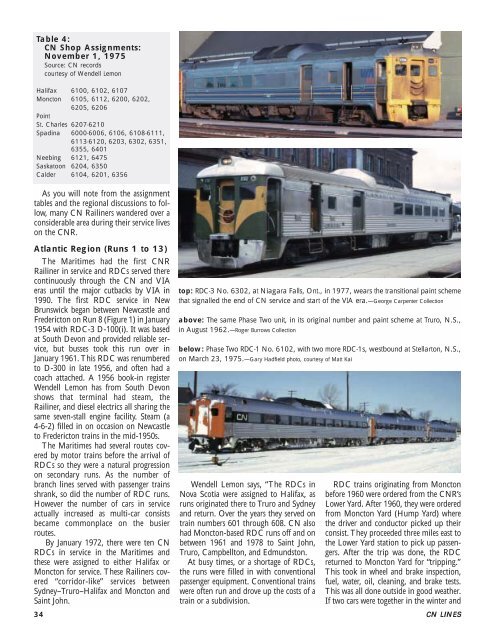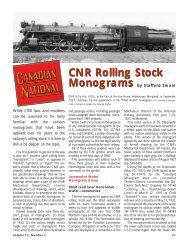CN LINES V12N3 - Canadian National Railways Historical Association
CN LINES V12N3 - Canadian National Railways Historical Association
CN LINES V12N3 - Canadian National Railways Historical Association
You also want an ePaper? Increase the reach of your titles
YUMPU automatically turns print PDFs into web optimized ePapers that Google loves.
Table 4:<br />
<strong>CN</strong> Shop Assignments:<br />
November 1, 1975<br />
Source: <strong>CN</strong> records<br />
courtesy of Wendell Lemon<br />
Halifax 6100, 6102, 6107<br />
Moncton 6105, 6112, 6200, 6202,<br />
6205, 6206<br />
Point<br />
St. Charles 6207-6210<br />
Spadina 6000-6006, 6106, 6108-6111,<br />
6113-6120, 6203, 6302, 6351,<br />
6355, 6401<br />
Neebing 6121, 6475<br />
Saskatoon 6204, 6350<br />
Calder 6104, 6201, 6356<br />
As you will note from the assignment<br />
tables and the regional discussions to follow,<br />
many <strong>CN</strong> Railiners wandered over a<br />
considerable area during their service lives<br />
on the <strong>CN</strong>R.<br />
Atlantic Region (Runs 1 to 13)<br />
The Maritimes had the first <strong>CN</strong>R<br />
Railiner in service and RDCs served there<br />
continuously through the <strong>CN</strong> and VIA<br />
eras until the major cutbacks by VIA in<br />
1990. The first RDC service in New<br />
Brunswick began between Newcastle and<br />
Fredericton on Run 8 (Figure 1) in January<br />
1954 with RDC-3 D-100(i). It was based<br />
at South Devon and provided reliable service,<br />
but busses took this run over in<br />
January 1961. This RDC was renumbered<br />
to D-300 in late 1956, and often had a<br />
coach attached. A 1956 book-in register<br />
Wendell Lemon has from South Devon<br />
shows that terminal had steam, the<br />
Railiner, and diesel electrics all sharing the<br />
same seven-stall engine facility. Steam (a<br />
4-6-2) filled in on occasion on Newcastle<br />
to Fredericton trains in the mid-1950s.<br />
The Maritimes had several routes covered<br />
by motor trains before the arrival of<br />
RDCs so they were a natural progression<br />
on secondary runs. As the number of<br />
branch lines served with passenger trains<br />
shrank, so did the number of RDC runs.<br />
However the number of cars in service<br />
actually increased as multi-car consists<br />
became commonplace on the busier<br />
routes.<br />
By January 1972, there were ten <strong>CN</strong><br />
RDCs in service in the Maritimes and<br />
these were assigned to either Halifax or<br />
Moncton for service. These Railiners covered<br />
“corridor-like” services between<br />
Sydney–Truro–Halifax and Moncton and<br />
Saint John.<br />
top: RDC-3 No. 6302, at Niagara Falls, Ont., in 1977, wears the transitional paint scheme<br />
that signalled the end of <strong>CN</strong> service and start of the VIA era.—George Carpenter Collection<br />
above: The same Phase Two unit, in its original number and paint scheme at Truro, N.S.,<br />
in August 1962.—Roger Burrows Collection<br />
below: Phase Two RDC-1 No. 6102, with two more RDC-1s, westbound at Stellarton, N.S.,<br />
on March 23, 1975.—Gary Hadfield photo, courtesy of Matt Kai<br />
Wendell Lemon says, “The RDCs in<br />
Nova Scotia were assigned to Halifax, as<br />
runs originated there to Truro and Sydney<br />
and return. Over the years they served on<br />
train numbers 601 through 608. <strong>CN</strong> also<br />
had Moncton-based RDC runs off and on<br />
between 1961 and 1978 to Saint John,<br />
Truro, Campbellton, and Edmundston.<br />
At busy times, or a shortage of RDCs,<br />
the runs were filled in with conventional<br />
passenger equipment. Conventional trains<br />
were often run and drove up the costs of a<br />
train or a subdivision.<br />
RDC trains originating from Moncton<br />
before 1960 were ordered from the <strong>CN</strong>R’s<br />
Lower Yard. After 1960, they were ordered<br />
from Moncton Yard (Hump Yard) where<br />
the driver and conductor picked up their<br />
consist. They proceeded three miles east to<br />
the Lower Yard station to pick up passengers.<br />
After the trip was done, the RDC<br />
returned to Moncton Yard for “tripping.”<br />
This took in wheel and brake inspection,<br />
fuel, water, oil, cleaning, and brake tests.<br />
This was all done outside in good weather.<br />
If two cars were together in the winter and<br />
34 <strong>CN</strong> <strong>LINES</strong>



